Exploring Horizon Kitchen and Bath: Design Meets Function
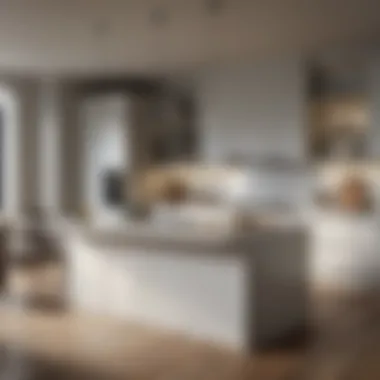
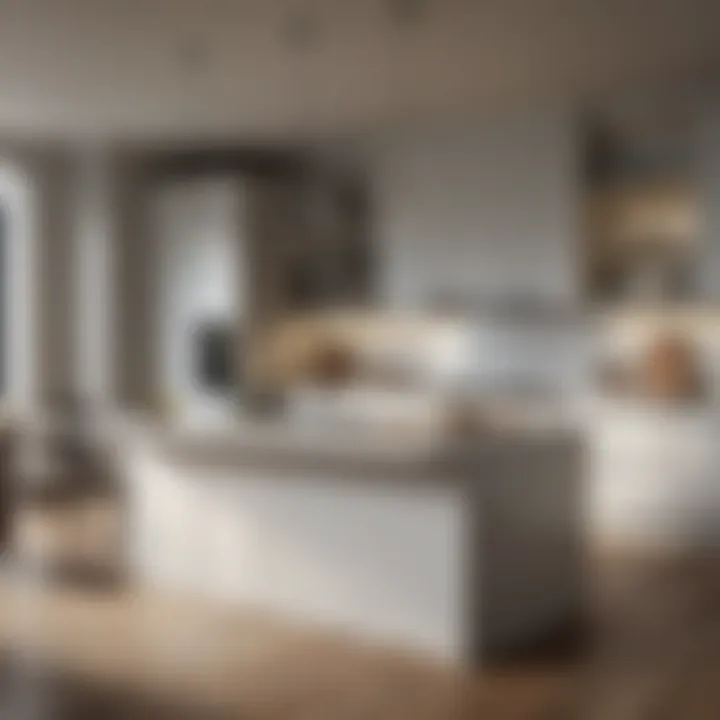
Intro
In a home, the kitchen and bathroom often serve as the heart and soul of everyday life. They are not mere functional areas; they embody style, comfort, and—quite importantly—wellness. In this guide, we explore the world of Horizon Kitchen and Bath, where design harmonizes with functionality. We dive into the latest trends, the visual allure of these spaces, and practical advice designed for housewives and homeowners aiming to elevate their living environments.
Current Trends
When it comes to kitchens and baths, the design landscape is continually evolving. The focus seems to always shift towards creating spaces that are both inviting and efficient. Here, we detail two key aspects of current trends—color palettes and popular styles.
Color Palettes
Choosing the right color can make or break a space. Lately, soft neutrals have made quite a debut. Think warm beiges or subtle grays, as these tones tend to create a calm, serene environment. However, bolder choices like deep navy or emerald green are also gaining traction, providing a splash of personality without overwhelming the space.
- Warm Neutrals: Beige, off-white, soft taupe.
- Bold Hues: Deep navy, forest green, rich burgundy.
- Accent Colors: Gold, brass, and softer pastels for a gentle contrast.
Popular Styles
Each wave of design has its own defining styles, and kitchens and baths are no exception. The current favorites blend traditional and contemporary influences, giving homeowners ample options to reflect their own taste.
- Modern Farmhouse: This style marries rustic charm with clean lines, featuring elements like shiplap walls and vintage-inspired fixtures.
- Minimalist: In a world brimming with distractions, the minimalist approach is appealing. It promotes clutter-free spaces adorned with functional yet chic fixtures.
- Industrial Chic: The raw and unfinished look of industrial design has found its way into kitchens and baths, emphasizing materials like concrete, metal, and exposed brick.
Visual Ideas
Visual appeal is paramount in any well-designed kitchen or bath. Creating stunning spaces often starts with a bit of inspiration. Here, we present a few ideas that can help shape your vision.
Gallery of Styled Bathrooms and Bedrooms
Envision step-free entry showers or freestanding tubs set against calming backdrops. This visual allure not only showcases aesthetics but also shares how thoughtful design can elevate functional areas.
Before-and-After Transformations
Transformations can breathe new life into tired spaces. A simple coat of paint or the right fixtures can drastically change a room's vibe. Before-and-after photos speak volumes, revealing how practical updates create serene havens.
"A well-designed space shapes our experiences, enhancing the daily routines we often take for granted."
Navigating the world of kitchen and bath design need not feel overwhelming. By staying informed about current trends and visual inspirations, homeowners can curate spaces that reflect not just style but a deeper sense of well-being. Whether contemplating a major overhaul or subtle updates, every little detail helps in crafting a home that speaks to personal tastes and needs.
Preface to Horizon Kitchen and Bath
The intersection of design and functionality is vividly illuminated in the spaces we often take for granted, like our kitchens and bathrooms. This article embarks on a journey through Horizon Kitchen and Bath, revealing how these areas are not just utilitarian, but integral to our living environments. With an emphasis on design that echoes personal style while ensuring practicality, let's dive into what makes Horizon Kitchen and Bath so significant in modern home design.
Defining Horizon Kitchen and Bath
Horizon Kitchen and Bath transcends basic home renovation; it represents a philosophy of creating environments that reflect individual tastes while serving vital functions. This concept is rooted in the understanding that the kitchen is not just a place for cooking, and the bath is more than just a room for hygiene. They are spaces for gathering, unwinding, and expressing one’s style.
From contemporary cabinetry to innovative fixtures, every aspect is intentionally chosen to balance aesthetic appeal with practical use. For instance, considering the layout of your kitchen is paramount in crafting an effective workspace. It's not about filling a room with nice things; it's about choosing the right elements that work cohesively and functionally.
The Role of Kitchen and Bath in Home Design
The kitchen and bath are often considered the heart of a home. These spaces significantly influence the overall ambiance and functionality of living areas. They are usually at the forefront when people evaluate a home's appeal.
The kitchen serves as a social hub, fostering connections between family and friends. Imagine hosting a holiday dinner while guests gather around the kitchen island, shooting the breeze as the aromas dance through the air. This social dynamic amplifies the importance of design; it needs to be both inviting and functional.
The bathroom, conversely, is a sanctuary, a personal retreat where one seeks solace amidst the chaos of a busy life. The design of this space can encourage relaxation and recovery. Simple adjustments, like incorporating soft lighting or choosing calming color schemes, can transform a regular bathroom into a personal spa haven.
Quote:
Trends in Kitchen Design
In the ever-changing realm of home design, keeping an eye on kitchen trends is like watching a chef whip up a gourmet dish: surprising, innovative, and ultimately a reflection of personal taste. The kitchen has long been the heart of the home, so understanding current trends helps homeowners and designers alike craft spaces that are not only functional but also aesthetically appealing. Emphasizing trends in kitchen design can assist in making informed decisions that enhance functionality while reflecting individual styles and preferences.
Contemporary Aesthetics
When we talk about contemporary aesthetics in the kitchen, we journey into a world filled with sleek lines, open spaces, and a blend of minimalist charm with practical appeal. Take, for instance, the rise of the open-concept layout. This design choice encourages a seamless flow between the kitchen and adjacent living areas, making it ideal for family gatherings and social events.
Moreover, materials used in contemporary kitchens, like polished quartz countertops, stainless steel appliances, and matte cabinetry finishes, contribute to a clean, sophisticated atmosphere.
- Natural Elements: Incorporating natural materials, such as wood and stone, introduces warmth while maintaining a modern edge.
- Neutral Color Schemes: The palette often revolves around whites, grays, and earth tones, creating a serene ambiance that makes spending time in the kitchen a pleasure.
Through these design elements, homeowners find themselves not only enhancing the visual appeal of their kitchens but also ensuring a lightweight and effortless aesthetic flow that is more welcoming.
Sustainable Practices
As awareness of environmental issues grows, sustainable practices are shaping the kitchen design landscape. Households are becoming increasingly conscious of their carbon footprints and opting for eco-friendly solutions. Designing a kitchen with sustainability in mind involves a few key factors; opting for materials that are renewable, recycled, or sustainably sourced.
For example, cabinets made from reclaimed wood or countertops crafted from recycled glass not only bolster durability but carry a compelling story as well.
"Investing in sustainable materials is not just a trend; it’s a long-term commitment to nurturing the environment."
Here are some sustainable practices to consider:
- Energy-Efficient Appliances: Choosing ENERGY STAR certified appliances helps reduce energy consumption without sacrificing performance.
- Water Conservation: Installing low-flow faucets can significantly reduce water usage, supporting eco-friendliness.
- Waste Reduction: Implementing recycling and composting stations in kitchen design not only minimizes waste but encourages sustainable habits within the household.
Engaging with modern kitchen trends isn't just about aesthetics; it’s also about making responsible choices that reflect a greater understanding of our environment. Feeling connected to your design choices brings not only a sense of pride but also the satisfaction of contributing to a sustainable future.
Modern Bath Innovations
Modern bath innovations are reshaping how we perceive and engage with one of the most vital spaces in our homes. With advancements in technology and design, today's bathrooms go beyond mere functionality; they have become sanctuaries for relaxation and rejuvenation. Let's explore some of the key elements that contribute to this transformation and how they enhance our overall living experience.
Smart Technology Integration
The infusion of smart technology into bathroom design is no longer a luxury; it’s quickly becoming a necessity. This trend covers a range of innovations, from intelligent toilets that offer self-cleaning features to mirrors that display the news or weather while you brush your teeth. Imagine waking up in the morning, stepping into a bathroom that adjusts the lighting and temperature to your preferred settings, thanks to smart sensors.
Besides convenience, smart technology offers significant benefits in terms of efficiency. For instance, water-saving shower heads and faucets now come equipped with sensors that reduce waste without sacrificing performance. This not only helps in conserving resources, but also lowers utility bills, making your bathroom eco-friendlier.
Moreover, smart ventilation systems can automatically detect humidity levels and adjust airflow, preventing mold and mildew problems that are common in damp spaces. As such devices become more integrated into our lives, their presence in our bathrooms is undeniable, bringing the ease of smart living right where we need it most.
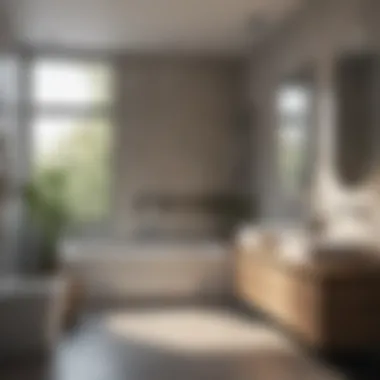
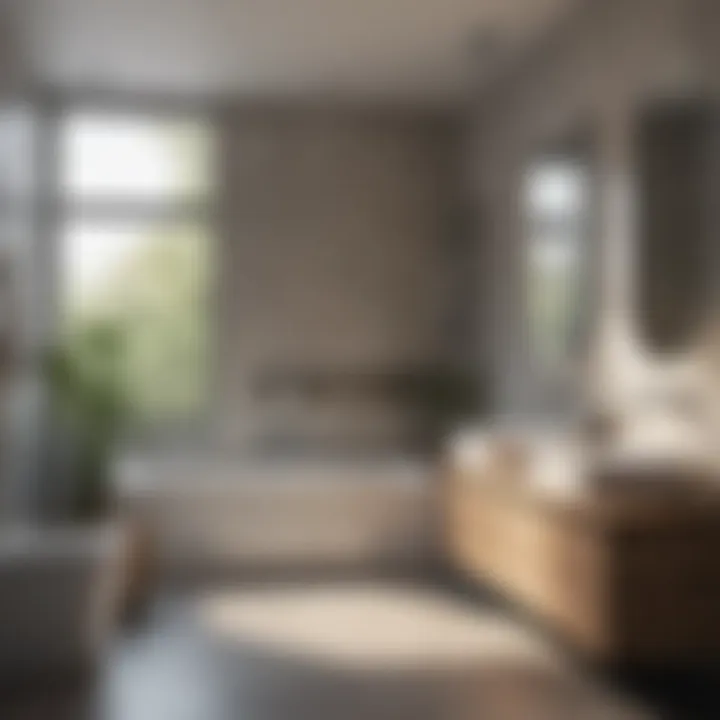
Wellness Features
Today's bathrooms are increasingly recognized as spaces of personal well-being, and this shift is reflected in the modern features being introduced. Wellness design emphasizes creating a calming atmosphere that's conducive to relaxation and stress relief. One popular feature is the incorporation of steam showers and soaking tubs, designed to mimic the restorative effects of a spa. These elements allow individuals to unwind after a long day, transforming a routine bath into a therapeutic experience.
"The modern bathroom can be a retreat, offering solutions to both physical and mental stress through thoughtful design elements."
In addition to fixtures for physical relaxation, sensory enhancements play a crucial role in fostering mental well-being. Aromatherapy diffusers, chromotherapy lights, and heated flooring are just a few examples of how sensory stimuli are being utilized to enhance the bathing experience.
Furthermore, the harmony of natural elements is increasingly prioritized in bathroom design. Many homeowners are opting for large windows or skylights to let in natural light and integrate plants that thrive in humid environments. Combining these features creates a serene oasis in the home, encouraging mindfulness and tranquility.
Key Elements of Functional Spaces
When it comes to crafting a kitchen or bath, the foundation lies within the key elements that define functional spaces. These elements are not merely aesthetic choices but are intertwined with the daily routines and comfort of those who inhabit them. The right design decisions can transform spaces from simple utility to indispensable havens of convenience and style.
Efficient Layouts
An efficient layout is the backbone of any successful kitchen or bath design. When spaces are arranged thoughtfully, they cater to how we move and interact with our environments. One principle to understand is the concept of the work triangle, particularly in kitchens. The work triangle connects the stove, sink, and refrigerator—three critical areas in the cooking process—with the aim of minimizing the distance between them.
In practical terms, a smartly designed kitchen might have the sink positioned centrally, with the stove and refrigerator easily accessible. This reduces unnecessary steps and allows for a more fluid cooking experience. For those who love to host, an open layout can facilitate social interactions without sacrificing functionality. Here are some considerations when planning efficient layouts:
- Traffic Patterns: Avoiding clutter and ensuring smooth flow is key. Entry points should remain unobstructed.
- Zone Designation: Defining cooking, preparation, and cleaning zones can streamline activities.
- Scaling for Space: For smaller kitchens, wall-mounted solutions can enhance space without feeling cramped.
Storage Solutions
Storage is often one of the most overlooked components in kitchen and bath design, yet its importance cannot be overstated. With numerous gadgets, linens, and essentials, an effective storage solution can spell the difference between chaos and organization. Custom cabinetry, for instance, can enhance aesthetics while providing the versatility needed to store everything from spice jars to baking trays.
Maximizing vertical space is a clever tactic worth exploring. Installing open shelves or tall cabinetry takes advantage of every available inch without overwhelming the visual appeal. Closed cabinetry, on the other hand, offers a tidy look and can conceal visual clutter, lending to a serene atmosphere. Here’s a breakdown of effective storage solutions:
- Drawer Dividers: Using dividers can help keep utensils and tools neatly organized.
- Pull-Out Shelves: These allow for easy access to items at the back, reducing the need to dig through clutter.
- Vertical Dividers: Ideal for pan storage, these make accessing cookware hassle-free.
By focusing on efficient layouts and storage solutions, homeowners can ensure their kitchens and baths are not just beautiful but also remarkably practical. Balancing design and functionality yields spaces that are equipped to handle the demands of daily life while still feeling inviting and stylish.
Material Selection in Kitchen and Bath
When embarking on the journey of designing or remodeling a kitchen and bath, the choice of materials is a pivotal step that can significantly influence both the aesthetic appeal and practical functionality of these spaces. The process of material selection extends beyond mere superficial appearances; it encompasses various factors including sustainability, durability, and maintenance considerations. Understanding the ramifications associated with these choices can empower homeowners to create spaces that not only reflect personal taste but also enhance their day-to-day living experience.
Choosing Sustainable Materials
In recent years, the relevance of sustainable materials has permeated the design world. The push towards eco-friendly options is not merely a trend; it serves as a vital response to environmental challenges. Choosing materials that are responsibly sourced protects our planet while also ensuring healthier living conditions for everyone.
For instance, consider reclaimed wood for cabinetry or flooring. This choice preserves the character of the material while significantly reducing the carbon footprint associated with new lumber production. Similarly, bamboo is a rapidly renewable resource that has taken the spotlight due to its durability and versatility. Homeowners can also explore options like recycled glass countertops or low-VOC paint to minimize harmful emissions inside their homes.
Beyond aesthetics, using sustainable materials can also lead to cost savings in the long run, thanks to longevity and energy-efficient technologies. With availability increasing, the choice of sustainable materials has never been easier or more appealing.
Durability vs. Aesthetics
The dialectic of durability and aesthetics is a fundamental consideration that affects material choice in kitchen and bath design. Homeowners often grapple with the allure of beautiful finishes against the harsh realities of everyday wear and tear.
For instance, natural stone surfaces like granite or quartz may exude luxury and elegance, but they come with their own maintenance requirements. On the other hand, laminate surfaces may offer versatility in design at lower costs and require far less upkeep, but they don't typically match the longevity of stone.
In practical terms, here’s how to balance these two aspects:
- Analyze Needs: Think about the level of use each space will see. Are there kids? Pets? Certain materials will withstand high traffic or spills better than others.
- Visualize: Visit showrooms or utilize design software to visualize differing materials in your space. Sometimes achieving that perfect look might only require a blend of materials.
- Research: Look into warranties and reviews for materials under consideration. A beautiful finish is lovely, but if it chips easily, the investment may not be worthwhile.
Ultimately, striking the right balance between longevity and appearance results in a kitchen or bath that satisfies both the eye and the functional needs of the household. As every homeowner knows, the balance between style and durability can be a fine line to tread, but with careful thought, one can achieve a satisfying compromise that stands the test of time.
Color Palettes for Serenity
When thinking about kitchen and bath spaces, color palettes hold a massive amount of sway over the overall vibe and harmony of these areas. It’s not just about picking pretty colors that look nice together; it's about how those choices can create an environment of calmness and balance. Emphasizing serene color palettes transforms these functional spaces into sanctuaries where homeowners can unwind and recharge. The right colors can make a space feel spacious, cozy, or even luxe, depending on how they’re employed.
Neutral Tones
Neutral tones have a special place in the design game. They act as the backbone of color palettes, offering versatility without overwhelming the senses. Shades like soft whites, gentle grays, and earthy beiges create a soothing atmosphere that allows the mind to ease off the hustle and bustle of daily life. These colors work wonders in smaller kitchens and bathrooms, too, as they reflect light and give an illusion of spaciousness.
- Much needed breath of fresh air: In a world filled with frenetic activity, neutral shades can act like a gentle hug. They promote a welcoming atmosphere, making family gatherings and hosting friends feel more relaxed.
- Foundation for personal expression: Neutral tones are like a blank canvas. They allow homeowners to showcase their personal style and decor choices without competing or clashing with the walls. A neutral backdrop means art pieces, fixtures, and textiles can pop.
What’s notable about neutral tones is their ability to shift depending on the lighting. For instance, a light beige may appear warmer in the morning sun but can take on a cooler feeling in dimmed evening light. Adapting to the natural changes throughout the day adds depth to the overall design.
Accent Colors
Now, let’s spice things up a bit. Accent colors are where the magic truly happens. While a neutral palette lays the groundwork, the right accents can enliven a space, adding personality and interest. Think of these like spices in a recipe; they enhance the main ingredients without overpowering them.
- Pop of energy: Deep greens, burnt oranges, or rich blues can elevate the neutral base, injecting energy into the room. An accent wall painted in a bold hue or vibrant accessories can become focal points, drawing the eye without causing chaos.
- Express individuality: Accent colors provide a prime opportunity for homeowners to express their unique tastes. Whether it’s via dishware or decorative pieces; bringing in hues that resonate on a personal level helps to make the space feel like home.
Effective use of accents can also draw attention to specific areas, such as a cozy reading nook in a kitchen or a stunning vanity in a bathroom. When strategically placed, they can make small areas feel more inviting, allowing the space to breathe while keeping the essence of tranquility intact.
"Color is the silent ambassador of your brand." - Paul Rand
In summary, choosing the right color palettes plays a crucial role in establishing a serene ambiance in kitchen and bath spaces. Neutral tones create the peaceful base, while accent colors breathe life into these areas, making them reflections of the occupant's character. The result? A harmonious sanctuary that balances design with the timeless need for calm.
Lighting Considerations
Lighting plays a pivotal role in kitchen and bath design, influencing not only how spaces are perceived but also their overall functionality. Choosing the right lighting can enhance the aesthetic appeal, create an inviting atmosphere, and significantly improve the utility of these areas. It's often said that good lighting can make or break a room, and nowhere does this adage hold truer than in the heart of the home—the kitchen and the bathroom.
Several elements must be considered when incorporating lighting, such as color temperature, intensity, and the sources of light. Each of these factors contributes to the ambiance and usability of the space. A well-lit kitchen can transform a mundane meal preparation into a delightful experience, while a bathroom illuminated with the correct lighting can evoke a feeling of tranquility.
Natural Light Integration
Natural light is like a breath of fresh air for any space. Integrating it into kitchen and bath design promotes an open and airy environment. This can be achieved through various means, such as large windows, skylights, or glass doors. The benefits are manifold. For one, natural light can make spaces seem larger and more inviting. Additionally, it fosters a connection with the outdoors, which is invigorating and refreshing.
Consider positioning windows in strategic locations to capture sunlight during the day. For example, a south-facing window can flood the kitchen with warm light. Not to mention, using reflective surfaces like mirrors or glossy finishes can amplify this effect, bouncing light around the room. Here’s a tip: consider installing sheer window treatments that let light in while still maintaining a level of privacy.
"Natural light not only brightens a space but also uplifts the spirit, making a culinary experience more enjoyable."
Layered Lighting Techniques
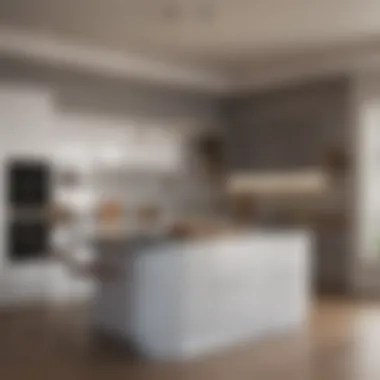
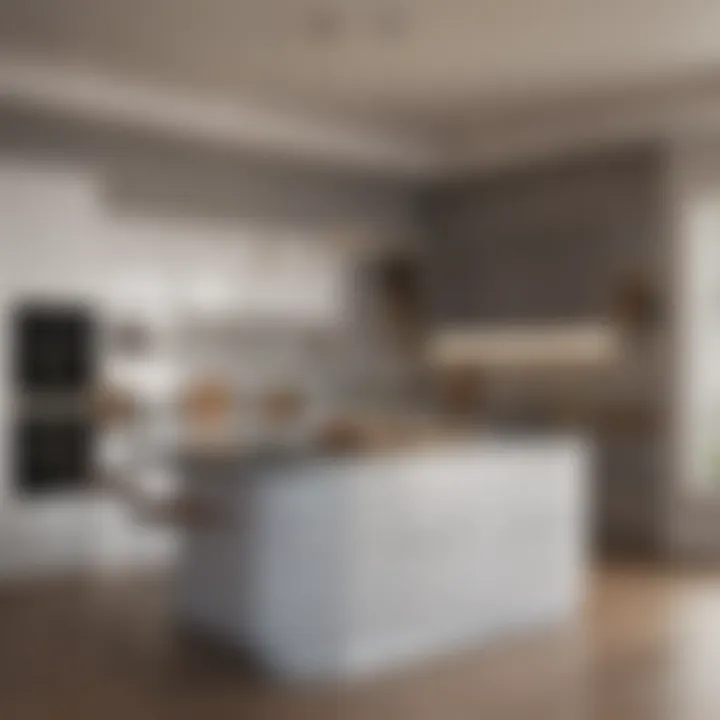
Layered lighting is an art form, integrating various types of lighting to create a harmonious and functional atmosphere. This approach involves three key components: ambient, task, and accent lighting.
- Ambient Lighting: This serves as the primary source of illumination, creating an overall glow in the kitchen or bath. Ceiling fixtures or wall sconces often play this role.
- Task Lighting: As the name suggests, this light is tailored for specific tasks—be it chopping vegetables, reading a recipe, or applying makeup. Under-cabinet lights or pendant lights above an island are quintessential examples.
- Accent Lighting: This small but impactful detail highlights certain features, like artwork or architectural elements. For instance, using LED strips to illuminate shelves can add a modern touch.
When you layer these various types of lighting, the result is not just functional but visually dynamic as well. The interplay between light and shadow can help define spaces and make them feel more cohesive. Planning your lighting around the activities you'll be doing in each area will enhance the overall user experience.
By considering both natural light integration and layered lighting techniques, you can achieve a kitchen and bath design that is both beautiful and practical. In short, light doesn't just illuminate—it elevates.
Functional Accessories
When it comes to cooking and cleaning in your home, functional accessories are the unsung heroes. They not only enhance the usability of your kitchen and bath but also play a critical role in sifting through the clutter and making day-to-day tasks smoother. Think of these items as the spice of life in your space; they can transform a mundane task into a more enjoyable experience.
Choosing the Right Fixtures
In the context of functional accessories, selecting the right fixtures is paramount. Fixtures include everything from faucets in the kitchen to vanity lighting in the bathroom. They are the backbone of design and functionality combined. When choosing fixtures, one should consider not just the aesthetic appeal but also how they contribute to the overall efficiency of the space.
For instance, opting for pull-down kitchen faucets can significantly ease the process of washing large pots or filling up tall containers. They add flexibility and comfort. Furthermore, light fixtures should provide ample illumination while reflecting your personal style. Under-cabinet lighting in a kitchen can enhance the overall ambience, making meal prep a pleasant affair.
- Consider compatibility: Ensure your fixtures match the existing design and layout.
- Functionality vs design: A stunning fixture is great, but it must also serve its purpose well.
- Ease of maintenance: Choose materials that are durable and easy to clean, to reduce future hassles.
Smart Kitchen Gadgets
In this fast-paced world, incorporating smart kitchen gadgets into your home can be a game-changer. They not only save you precious time but also elevate your cooking and cleaning experience. From Bluetooth-enabled kitchen scales to automatic sinks, these gadgets are designed to enhance efficiency.
For example, a smart oven can allow you to control cooking temperatures and times remotely, giving you greater flexibility in your meal preparation. Similarly, smart dishwashers can optimize water usage and provide effective cleaning cycles while you attend to other tasks.
In addition, some gadgets have been designed with sustainability in mind, utilizing less energy and water than traditional models. This aligns perfectly with the growing trend toward eco-friendliness and conservation in home design.
"Investing in thoughtful functional accessories can provide unprecedented convenience and a touch of modernity to any home."
These items aren’t just techy tools; they are integral parts of a well-thought-out design that values functionality alongside aesthetics. Embracing these innovations can profoundly impact your kitchen and bathroom experience. In summary, both the right fixtures and smart gadgets come together to create a harmonious home environment where functionality and design coexist perfectly.
Designing for Small Spaces
Designing for small spaces has become an essential focus in modern interior design, especially in urban environments where apartments and houses often come with limited square footage. The reality is that we live in spaces that reflect the way we choose to live, and making the most of those spaces can greatly enhance both functionality and aesthetics. In the realm of kitchens and baths, optimizing small spaces not only improves usability but also elevates the overall design experience.
Maximizing Vertical Space
When working with compact areas, vertical space presents a significant opportunity. Instead of simply looking around you, look up—there’s a wealth of potential waiting just above eye level. Wall-mounted cabinets are your best friends. They provide storage without consuming precious floor space, making room for more important elements like traffic flow or additional appliances.
- Consider using open shelving as well. This not only offers a place to show off beautiful dishes or decorative items but also creates the illusion of a more open environment.
- When installing cabinets, reaching up is key. Sizes and heights should be considered so you can maximize every inch.
- Don’t forget about the often neglected area above the refrigerator. Adding custom cabinetry or shelving here can turn a dead zone into a valuable storage area.
To put it simply, utilizing vertical space is like tapping into a hidden resource. By building upward, you unlock the potential which can make your kitchen or bath feel larger and more organized.
Multipurpose Furniture
Another smart approach in small spaces involves the clever use of multipurpose furniture. This type of furniture does double or even triple duty, enabling you to maximize utility while minimizing clutter. Think of it as having a Swiss Army knife among your furnishings. Each piece serves a distinct purpose, yet all come together seamlessly.
- For kitchens, a dining table that doubles as a food prep station can save crucial space and time. Some extendable tables can be adjusted for more guests when needed.
- In baths, a vanity with storage underneath can keep every essential within easy reach while maintaining a clean surface area.
- Wall-mounted foldable desks or drop-leaf tables can be incredibly beneficial. They provide a workspace when you need it but can be tucked away when not in use.
By selecting furniture that serves multiple functions, you keep your design clean and your space efficient, all while enjoying a cohesive look that doesn’t sacrifice style.
In small spaces, strategic choices can lead to a transformative design experience.
Eco-Friendly Bathroom Solutions
In recent years, the focus has shifted toward sustainability in home design, and the bathroom is no exception. Adopting eco-friendly bathroom solutions not only benefits the environment but can also lead to cost savings and improve overall quality of life. Understanding the significance of making green choices in this often-overlooked area can assist homeowners in fostering a space that is both functional and environmentally conscious.
One of the main reasons for the push toward eco-friendly solutions in bathrooms is the impact on water conservation. Bathrooms are notorious for high water usage, particularly due to showers, baths, and toilets. Choosing features designed to reduce water consumption can lead to substantial reductions in utility bills while aiding the planet simultaneously. This dual benefit is essential in today’s world, where resources are becoming increasingly precious.
Moreover, creating a bathroom with sustainable solutions promotes a healthier environment. Materials that are sourced responsibly and have low volatile organic compounds can improve indoor air quality. Additionally, eco-friendly products often feature designs that embrace natural elements, aligning well with the broader trends in home decor aiming for a serene and inviting atmosphere.
"Every drop counts! By making a few adjustments in your bathroom, you can contribute to conserving this precious resource."
Water-Saving Fixtures
Implementing water-saving fixtures is an effective way to enhance eco-friendliness in bathroom design. These fixtures are specifically engineered to utilize lesser amounts of water without compromising on performance. Low-flow showerheads, for instance, can reduce water usage by approximately 30-50% compared to traditional models. Such efficiency doesn’t just save water; it also translates into lower energy bills, as hot water heaters work less hard.
Another key component is the dual-flush toilet. These toilets offer two flushing options: one for liquid waste and another for solid waste. They can save a household thousands of gallons of water annually. In addition to these, faucet aerators can be installed to minimize water flow while maintaining pressure. This simple but effective solution is often overlooked, yet it can yield impressive results with little effort.
Compostable Materials
Incorporating compostable materials into bathroom renovations is a step towards a sustainable future. However, not all materials are equal when considering environmental impact. Traditional construction and decorative items, like vinyl wallpaper or plastic containers, can add up to significant waste as they do not break down naturally.
Alternatives such as bamboo, recycled glass, and sustainably sourced wood offer sustainable choices that also bring warmth and style to a bathroom space. For example, bamboo is a grass that grows incredibly fast, making it an ideal renewable resource. Similarly, recycled glass tiles can add a pop of color while doing a good deed for the environment. Not only do these materials minimize waste, but they also contribute to a bathroom ambiance that feels fresh and earthy.
In summary, integrating eco-friendly bathroom solutions creates a win-win situation. Homeowners can embrace design choices that prioritize sustainability without sacrificing functionality or aesthetic appeal. By selecting water-saving fixtures and compostable materials, individuals are contributing to a collective effort to preserve resources and enhance personal well-being.
Creating a Spa-Like Atmosphere
In the hustle and bustle of daily life, the idea of transforming your kitchen and bath into a serene retreat beckons many. A spa-like atmosphere not only rejuvenates the senses but also promotes well-being, making these spaces more than just functional areas in the home. Instead, they evolve into personal sanctuaries where you can unwind and recharge. This section emphasizes the importance of crafting these tranquil environments by exploring key elements, benefits, and practical considerations for achieving this goal.
Incorporating Natural Elements
Integrating natural elements into your kitchen and bath can significantly enhance the ambiance. Think of materials like wood, stone, and plants. The warmth of untreated wood, for example, can effortlessly bring in a touch of nature. It's not just about looks; adding natural materials promotes a sense of calmness and connection to the earth. Pintrest boards filled with houseplants can serve as inspiration, as greenery is known to purify air and soothe the mind.
- Wood Accents: Popular choices like bamboo or reclaimed wood offer an organic feel. You might consider wooden shelves or a rustic dining table to inject warmth into your space.
- Natural Stone: Materials such as granite and marble help in creating that luxurious, spa-like vibe. Countertops and vanities made from these stones lend an air of elegance and durability.
- Plants: Incorporating a few potted herbs in the kitchen or a snake plant in the bathroom can make a huge difference. They not only look great but also contribute to a healthy indoor environment.
When integrating these elements, remember that less is often more. A few well-placed pieces can set the mood without overwhelming the senses. Think about setting a few stones on a windowsill or having a small indoor water feature; the trick is to allow nature's beauty to shine through without cluttering the space.
Sound and Scent Enhancements
While sight influences ambiance hugely, sound and scent play complementary roles that shouldn’t be overlooked. Creating an auditory backdrop can transform your kitchen and bath into a calming oasis. Soft instrumental music or the gentle sounds of nature, whether it’s the rustling of leaves or the soft trickling of water, can provide a relaxing distraction from the overwhelming sounds outside.
To enhance this atmosphere, scent is your ally. Aromatherapy has long been known to uplift and relax, so consider incorporating these elements to heighten the experience. Here are some ideas:
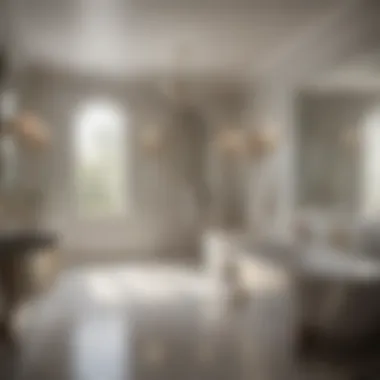

- Scented Candles or Oils: Lavender and eucalyptus are fitting choices that remind one of a tranquil spa experience.
- Essential Oil Diffusers: These allow you to easily change your space's mood with a few drops. You can mix and match to suit the time of day or your mood.
- Soothing Sounds: Installing a small speaker system that plays soft instrumental or nature sounds can help set the desired mood.
By emphasizing both tactile experiences and the surrounding atmosphere, it's entirely possible to introduce that sought-after spa-like essence into the heart of your home.
In summary, creating a spa-like atmosphere hinges on incorporating natural elements and paying close attention to auditory and olfactory enhancements. By combining these factors, your kitchen and bathroom spaces can be transformed into havens that encourage relaxation and promote overall well-being.
Optimizing Workflow in Kitchen Design
Optimizing workflow in kitchen design is more than a mere consideration; it's essential for creating a functional and enjoyable space. Efficiency can make or break the cooking experience, especially in a busy household. As families juggle work and home life, the kitchen often stands at the core of activity. Designing with workflow in mind maximizes usability, minimizes frustration, and enhances overall enjoyment.
The Work Triangle Concept
One of the fundamental principles in optimizing kitchen workflows is the Work Triangle Concept. This method centers around the relationship between the three most used areas in the kitchen: the sink, stove, and refrigerator. The efficiency of this triangle affects how seamlessly culinary tasks can be completed.
- Sink: Often the heart of kitchen activities, a well-placed sink serves multiple functions—from cleaning veggies to washing dishes.
- Stove: The cooking hub where heat and skill mingle. Its location should facilitate easy access to prep areas and the sink alike.
- Refrigerator: Keeping food fresh and at your fingertips is vital. It should be conveniently located but not in the way.
The optimal distances between these points should ideally fall within a range of 4 to 9 feet, creating a convenient and efficient workflow. This allows you to move around freely, minimizing backtracking and interruptions. Remember to consider the kitchen layout as well, whether it's U-shaped, L-shaped, or a galley style, to best accommodate this triangular arrangement.
The balance of the work triangle streamlines kitchen activities, adding to the culinary experience instead of becoming an obstacle.
Zones for Specific Activities
In addition to the Work Triangle Concept, defining zones for specific activities is another vital strategy. This approach helps with organization and efficiency, allowing family members to engage without stepping on each other's toes. Here’s how you can break it down:
- Preparation Zone:
- Cooking Zone:
- Serving Zone:
- Cleaning Zone:
- Storage Zone:
- Equip with ample counter space, cutting boards, and knife storage. A designated area for meal prep can help keep the kitchen serene while cooking.
- This area should house the stove and relevant pots, pans, and utensils. Everything you need should be within arm's reach to maintain flow during cooking.
- Consider where you'll plate up meals. Having a surface nearby helps in easing the transition from cooking to dining.
- Make your cleanup easier. Place waste bins and dish racks near the sink or dishwasher. It cuts down on unnecessary movement during the often-overlooked cleanup task.
- Organize pantry items, pots, and dishware strategically. Closer proximity to the cooking area increases efficiency by reducing time spent searching.
By establishing specific zones, you create a fluid space where actions transition effortlessly from one to another. This orchestration of task areas can transform a chaotic environment into a well-coordinated one, allowing for more productive cooking moments and family gatherings.
In sum, optimizing the workflow in kitchen design is about making life simpler, smoother, and more pleasurable. By paying attention to the work triangle and zoning activities properly, you ensure that every cooking session is a delight, not just a chore.
Personalizing Your Space
Personalizing your space is about much more than just slapping up a few family photos or picking out a trendy vase. It plays a pivotal role in making a house feel like a home. The kitchen and bathroom are, arguably, two of the most utilized areas in any dwelling, and they can greatly benefit from thoughtful personalization. A well-tailored environment reflects the inhabitants’ identities, and, in doing so, facilitates comfort and creativity.
In the context of Horizon Kitchen and Bath, personalizing these spaces can maximize both their beauty and functionality. Homeowners are encouraged to delve beyond conventional aesthetics to craft environments that resonate with their individual tastes and lifestyles. Here’s what to consider:
- Function Meets Form: Tailoring your space should not compromise practicality. It is critical to think about how designs serve the household. For example, if you enjoy cooking, your kitchen should reflect that by prioritizing layout and appliance placements that suit your culinary routines.
- Emotional Connection: Spaces shaped by personal style can enhance well-being. An inviting ambiance lowers stress and fosters relaxation, especially in the bathroom, which can lower the daily grind. Consider colors and textures that evoke comfort and calmness.
- Cultural Influences: Personalization can also stem from cultural identities. Drawing inspiration from one’s heritage can create a unique blend of style. Incorporating traditional design elements or artifacts into modern settings can strike a refreshing contrast.
"A home that echoes the soul of its inhabitants transforms mere aesthetics into a storytelling medium."
Incorporating your own narrative into the design enhances not just your space but your life within it. With that in mind, let's explore how to further blur the lines between creativity and functionality in your kitchen and bath.
Incorporating Personal Style
To pave the way for a truly personalized atmosphere, integrating individual style is essential. This begins by defining what resonates with you — perhaps you’re drawn to rustic wooden finishes or sleek contemporary lines. Here are steps to guide you:
- Mood Boards: Creating a mood board can help distill your aesthetic preferences. Collect images, fabric swatches, and color samples that appeal to you.
- Functional Decor: Choose items that not only look good but also serve a purpose. For instance, decorative jars for spices that double as aesthetic touches in the kitchen.
- Mix and Match: Don’t feel bound to a single style. Juxtaposing different influences can yield an eclectic yet harmonious design. Think about how modern appliances can be accented with vintage utensils or art pieces.
Art and Decor Choices
Art and decor are vital elements that can transform dull spaces into unique showcases of personality. The right artwork can change the atmosphere of a room instantly. Consider these key points when selecting your art:
- Scale and Proportion: Choose pieces that complement the space. A massive painting on a small wall can feel stifling, while tiny prints may get lost in larger areas.
- Thematic Consistency: While variety is needed, a thread of continuity can create cohesion. For instance, a consistent color palette across different pieces can tie your space together organically.
- Meaningful Pieces: Consider incorporating artworks or decorations that hold personal significance. This brings deeper emotional investment into your design, whether it’s a piece from a cherished trip or a family heirloom.
The Future of Kitchen and Bath Design
As we gaze into the crystal ball of interior design, it becomes increasingly clear that the future of kitchen and bath design is a concoction of innovation, personalization, and sustainability. These spaces are no longer just about functionality; they’re evolving into realms where technology and style coalesce, offering homeowners not just a place to cook or bathe, but a holistic experience that resonates with their lifestyle and preferences.
Emerging Technologies
Emerging technologies are breathing new life into kitchen and bath design, transforming ordinary spaces into vibrant hubs of efficiency and luxury. One main aspect to consider is the integration of smart home technology. Imagine controlling your kitchen lights, temperature, and even cooking appliances from your mobile device. This level of connectivity streamlines tasks and enhances convenience. Equipped with smart faucets, for example, you can easily adjust water temperature and flow with just a voice command or a gentle touch.
Another tech trend making waves is augmented reality. This feature allows homeowners to visualize their space with various materials and layouts before committing. You can view digital mock-ups of countertops, cabinetry, and more right within your own home. It minimizes trial and error, potentially saving a good chunk of time and cost.
Then, there’s the growing popularity of energy-efficient appliances. These advancements not only foster a more sustainable living but also resonate with the growing consumer demand for lower utility bills. Upgrading to energy-efficient solutions can mean a significant long-term saving, plus peace of mind knowing that you're doing your part for the environment.
Shifts in Consumer Preferences
Shifts in consumer preferences are shaping the landscape of kitchen and bath design. Homeowners are becoming more discerning in what they want from their living spaces. It’s not just about white cabinets and stainless steel fixtures anymore; the push is towards more customizable and personalized options.
For instance, an increasing number of consumers are seeking unique materials that tell a story. Instead of standard tiles, homeowners are opting for reclaimed wood or ethically sourced stones that add character and warmth. This trend towards personalization is about connecting with one’s home on a deeper level, making it truly reflective of one's taste.
Additionally, the focus on well-being is stronger than ever. Homeowners are searching for design features that promote health and tranquility. Products like water filtration systems integrated into the kitchen sink or spa-like features in the bathroom are becoming sought-after. The aim is to create spaces that nourish not just the body but also the spirit.
"Embracing the future of kitchen and bath design means prioritizing not just aesthetics but also how these spaces contribute to a holistic lifestyle."
In summary, the future of kitchen and bath design is a vibrant mix of technology, material innovation, and personalized spaces that cater to the sophisticated tastes of modern homeowners. The shift towards sustainable and wellness-focused elements is not just a passing fad; it’s a clear indicator of how our living environments can evolve to meet the demands of contemporary life.
Epilogue: Achieving Balance in Design
Achieving balance in design is not merely a recommendation; it is a necessity in creating kitchens and baths that not only appeal aesthetically but also serve practical functions. The overall objective should be to satisfy both form and function, allowing the spaces to fulfill their roles while also reflecting individual style. In the context of Horizon Kitchen and Bath, this balance leads to environments where inhabitants can thrive.
When discussing design balance, several crucial elements come into play. These can include understanding the significance of layout, material selection, and color schemes:
- Layout: A logical, efficient layout is paramount. The configuration of a kitchen or bath doesn't just impact how these spaces look but also how they operate. For instance, the work triangle, which connects the stove, sink, and refrigerator in a kitchen, can dictate ease of use. A well-thought-out layout minimizes wasted motion, leading to a smoother workflow.
- Material Selection: The choice of materials impacts not just the beauty of a space but its functionality and longevity. Selecting durable materials that can withstand daily wear and tear without compromising aesthetics is key. For instance, quartz countertops may offer both timelessness and resilience, blending practicality with style seamlessly.
- Color Schemes: Colors establish an emotional connection to a space. Neutral tones can create a sense of calm, while strategic bursts of color can energize. The interplay of colors should aim to create harmony, enhancing the overall experience of the kitchen or bath.
Benefits of Achieving Balance:
Striking this balance comes with a multitude of benefits:
- Enhanced Functionality: A well-balanced space ensures that functionality is not overshadowed by aesthetics. Homeowners can navigate these spaces effortlessly, making daily tasks more enjoyable.
- Improved Aesthetics: When design elements complement one another, the results are visually pleasing. This balance fosters an inviting atmosphere that resonates with a household's style.
- Increased Value: Balanced spaces generally lead to higher property values. Potential buyers are more likely to appreciate a well-thought-out design, making the investment in quality and balance worthwhile.



